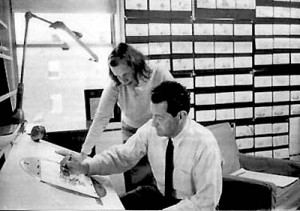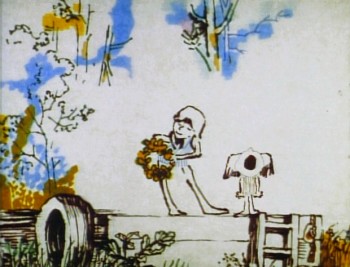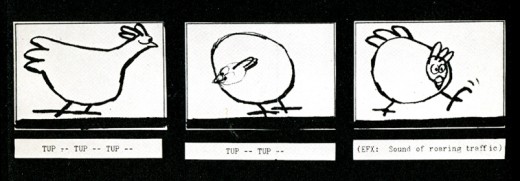Animation Artifacts &Hubley &Story & Storyboards 28 Feb 2007 08:04 am
Hub Boards
- The conversation on storyboard use goes way back – before the internet. If you check out the 1969 book by John Halas, Techniques of Film Animation, there’s a Q&A session wherein a number of animation greats were asked several questions, and the answers are given by question.
Here’s one question about storyboards and the answers given:
To what extent to you think a storyboard should be developed prior to production?
- GENE DEITCH: I believe in complete scene and shot breakdown in story-board or a thumbnail board form before production begins. I use a thumbnail storyboard as a sort of bar-sheet, indicating all effects, dialogue and music cues, scene transitions, etc. Great savings in cost, and an overall perspective of the film in advance are to be gained.
JOY BATCHELOR : As fully as possible without detriment to the following phases of production.
STEHPEN BOSUSTOW: If time and money allow, the storyboard should include as many details as possible, particularly if it is to be assigned to a large production unit. However, if only a few people are to be working on the picture, the storyboard can be quite sketchy, with the details being developed during production by the key people who have an overall feeling for and knowledge of the story.
ADRIAN WOOLERY: The storyboard is the first step, after the idea. Every problem must be solved and the story completely resolved on the board prior to consideration of any production.
 JOHN HUBLEY: It has been my experience that the more detailed a story-board and the more carefully it is designed to reflect the appearance of the finished production, the more successful the film.
JOHN HUBLEY: It has been my experience that the more detailed a story-board and the more carefully it is designed to reflect the appearance of the finished production, the more successful the film.GEOFFREY SUMNER: The storyboard, or breakdown of the film, has as many different forms as there are ways of putting actions in relation to one another.
The classic storyboard is the set of working drawings of the sequence of a film used in large studios on the Disney model where numbers of subsidiary workers must conform to a total pattern they can almost never see.
It is used in conjunction with model sheets. It could be called the “model sheet” of the sequence of the film.
It is strictly for use within a studio and should not be shown to dangerous people like sponsors.
An earlier stage is the treatment, which can be specifically directed at sponsors. If the basic idea of the film is simple, the treatment need be no more than half a dozen drawings and a brief synopsis to convey a ten minute film.
A storyboard must necessarily be constructed after the music has been done. The musician and the director can work together from a stage following the treatment. From the finished recorded track the storyboard is made.
 For years prior to even meeting Hubley, I had remembered his response to this question. It impressed me. His storyboard development was pretty intense. The scripts generally were done visually and tacked to the wall.
For years prior to even meeting Hubley, I had remembered his response to this question. It impressed me. His storyboard development was pretty intense. The scripts generally were done visually and tacked to the wall.
I don’t remember ever seeing text up there. John would present the board to key people, and he would give an indication of dialogue verbally. We all knew this would ultimately be ad-libbed by actors.
With the Carousel feature, sections were boarded but then developed in greater  length through improvised sessions. The boards then grew out of the edited tracks. The voices often came first, here.
length through improvised sessions. The boards then grew out of the edited tracks. The voices often came first, here.
I suspect this is probably also true of the films like Cockaboody, Windy Day and Moonbird which were dependent on the children’s verbal play at the microphone. Something like The Hole or Voyage To Next were boarded visually, then recorded improv sessions which were adapted in newer boards.
Of course it has to be remembered that the two features done within this studio, Everybody Rides The Carousel and Of Stars and Men, both started out as text. Both were heavy-duty books that were adapted for film. In the case of Of Stars and Men, the author, mathematician Harlow Shapely had major involvement in the film’s script and narrated it as well. The concepts for both films were fully worked out before anyone started boarding. So essentially a script – of sorts – existed. Since CBS financed Everybody Rides The Carousel, you know they had to approve a script.
I, of course, only remember the board.


on 28 Feb 2007 at 7:26 pm 1.Eddie Fitzgerald said …
Wow! Interesting comments by interesting people! Thanks for putting them up! Thanks also for posting about your own method of working, which struck me as rational and commendable.
My antagonism to non-artist writers comes from my experience in comedic TV animation where they dominate the field.
1)They write long, double-length scripts because editing them to a reasonable length would be too time-consuming and would interfere with their freelance.
2)They shamelessly write gag cartoons, which artists hate and which makes any real attempt at comedy futile.
3)They create characters that don’t lend themselves to visual comedy. Even on the extremely rare occasion when an artist has an opportunity to do a funny visual the effort is hamstrung by the one-dimensional, verbal sort of cliche characters he’s forced to work with.
I could add another half dozen points but that’s enough for a start.
on 28 Feb 2007 at 9:34 pm 2.Michael said …
I couldn’t agree with you more about the scripts I’ve seen. I’ve been lucky enough to have been able to choose my writer and rework many of the scripts I’ve directed. It’s an advantage most animation directors don’t see doing TV work (and probably feature work as well.) Although, I’m sure there are good writers out there; producers just have to find them.
on 01 Mar 2007 at 3:17 am 3.Eddie Fitzgerald said …
Holy Cow! On item #2 I wrote “gag” cartoons when I meant to say “gang” caroons. That’s a big error! Artists love to work on gag cartoons, it’s “gang” cartoons that give us nightmares.
By gang I mean cartoons which feature six friends who go everywhere together and who have traits like the inventer, the over-eater, the nerd, the skateboarder dude, the perky over-achiever girl, the hip oldster, etc.
Thanks for the reply. Choosing your own writer is a big help because in that case the writer feels obligated to listen to the director’s views. In TV animation a writer who disagrees with a director will often go over the director’s head to the producer and may even try to get the director fired. The TV industry would improve overnight if one simple reform was put into effect: that writers should be hired by the director and not by the producer.
on 01 Mar 2007 at 8:12 am 4.Michael said …
I corrected “gang” to “gag”. There was no doubt what you meant from the context of what you were saying. I don’t think anyone was confused.